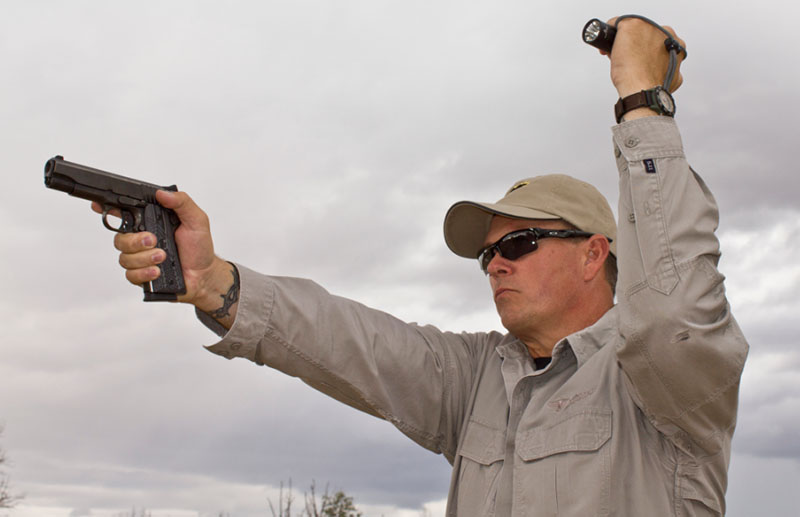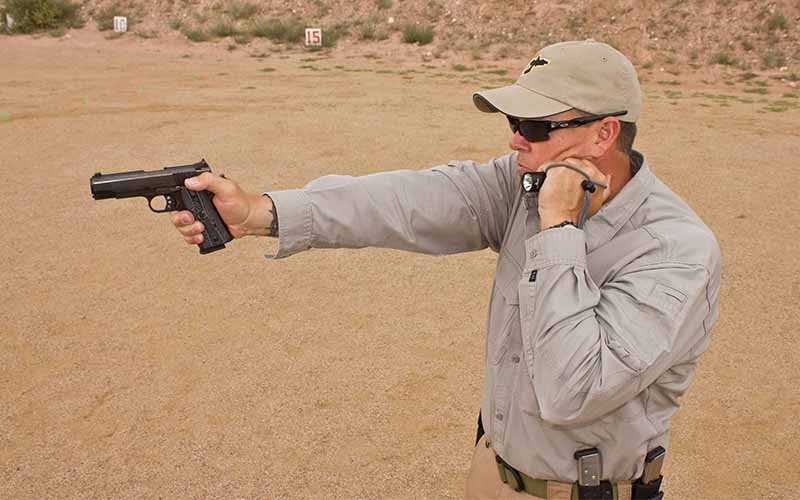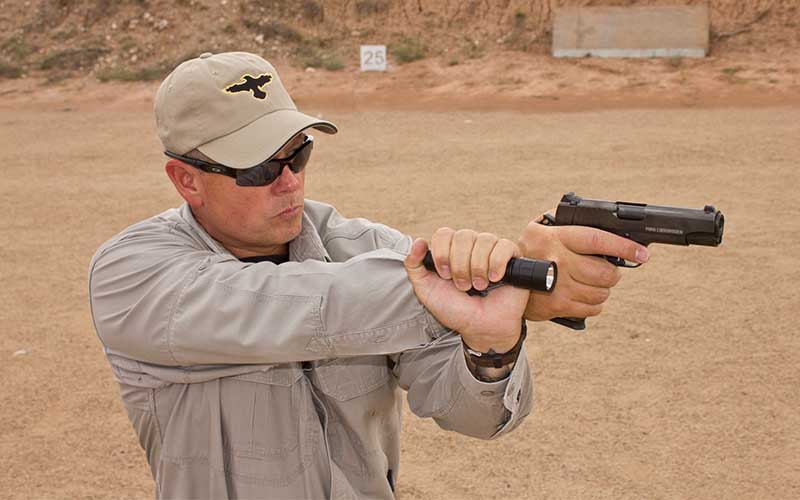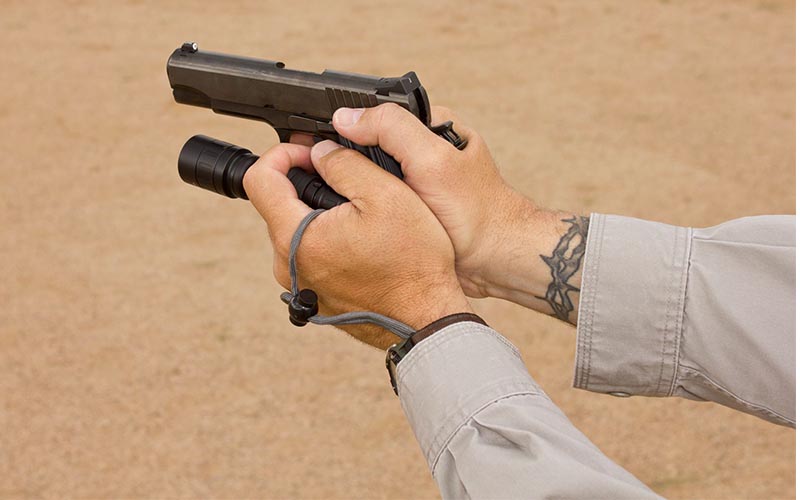
Here are some top self-defense flashlight techniques for using a handheld light in conjunction with a pistol.
It wasn’t all that long ago when a flashlight was just a flashlight. You picked one up at the Dollar Store, shoved some D-cells in it and went on your way. About 25 years ago, one of the best flashlights you could buy was the standard, old, Maglite. This was the heavy and long aluminum flashlight that was preferred by cops because it was moderately bright and, well, stick-like.
Today, hundreds of bright, durable, compact flashlights are designed with personal protection in mind. When selecting one for use with your handgun, you can start by applying the rule of the four Ls. It should provide a minimum of 100 lumens, be powered by lithium batteries, have a LED bulb and come or be compatible with a lanyard. The light should also have tailpiece activation.
With a good, reliable light source in hand, the next question is: How do you use it in conjunction with your handgun? There are several techniques, and they all have their pros and cons. There’s no best answer other than, maybe, becoming proficient with them all and employing the one that best fits the situation.

The FBI Technique
Thinking that bad guys might shoot at your light because they think that’s where you are, the FBI developed this technique. You hold the flashlight away from your body—out to the side and up—in your non-shooting hand as you search for and engage targets. This is a tactically sound method for searching, but once you start shooting, it sort of negates the need to hold the flashlight away from your body. Also, shooting with one hand isn’t the best way to get hits.
Neck Index
Maybe best thought of as a progression technique, the neck index method lets you transition from looking to shooting. Let’s say you’re using the FBI technique to search, and you see a threat. You can pull the light to the neck index method as you start weapon presentation.
With the light indexed at your neck, it’s similar to your support hand being at the center of your body during normal weapon presentation. All you do is pull your flashlight hand up to your chin with the bright end oriented toward the threat. One your gun is oriented toward the threat, it’s probably best to transition to one of the next two flashlight methods.

The Harries Technique
Embraced by Gunsite, this technique is likely the most often taught technique at law enforcement academies. Why? Partly because it works just as well with flashlights that have the activation button on the end or on the flashlight body, partly because it’s easy to use—and partly because it allows for two-hand support of the handgun.
With the Harries technique, you lock the backsides of your hands together. To employ, slip your flashlight hand under your shooting arm and then lower the elbow of your flashlight arm. This applies pressure against the backside of your gun hand and makes for a relatively stable shooting platform.

SureFire Technique
This is arguably the safest and fastest method to assume of any of the flashlight techniques, but it’s also possibly the most difficult to master. You’ll need a small flashlight with an activation button on the end of the tailpiece and, ideally, a rubber grommet positioned just a few inches forward.
SureFire used to manufacture lights just for this purpose, but at last check they’d all been discontinued. Hold the flashlight like a syringe between the index and the middle finger of your shooting hand, and use your bottom two fingers to help grip the gun. The trick is learning to orient the light with the handgun. Most commonly, shooters tend to point the light toward the ground. This isn’t all that bad. Generally, there will be enough light splashing off the ground to light up the target.

In General
The Harries and SureFire self-defense flashlight techniques offer the most stable shooting platforms, but they have a major drawback: If you’re searching your home, backyard or anywhere else using either technique, whatever you point your flashlight at you’re also pointing your handgun at. Alternatively, if you select a light with a wide flood beam, you can search using these techniques while holding the handgun at the low ready and looking with the edge of the beam. Just let the light splash up from the ground. Still, the potential for problematic response is there, and it’s not always a good idea to have your handgun out if you don’t know exactly what you might be facing.
A safer approach would be to keep the handgun in the holster, at your side or tucked in tight against your body at the close ready with the muzzle pointed in a safe direction. If you encounter a threat, you can immediately transition to the neck index technique, point your pistol and assume the SureFire or Harries technique or just transition right into either. The best solution is a handheld light used in conjunction with a weapon mounted light—we’ll cover that here in the future.
Finally, a lanyard on your self-defense flashlight is always a good idea. It keeps the light close at hand if you accidentally drop it … or if you need to let go of it to open doors, call 911, perform a reload or if you’re using it in conjunction with a weapon light and want to shoot with the common two-handed grip.
By itself, a flashlight is a powerful self-defense tool that can and should be used independent of the handgun. You can use it when you’re walking across a parking lot or even when on the sidewalk to check alleys or suspicious characters.
I spent my honeymoon in the French Quarter of New Orleans and carried a compact, tactical flashlight and a Colt Lightweight Commander during every excursion on Bourbon Street and beyond. I never had to use the Colt, but the flashlight got a lot of use.
Editor's Note: This article originally appeared in the November 2022 issue of Gun Digest the Magazine.
More On Tactical Lights:
- What You Need To Know To Buy The Best Flashlight
- Inforce Wild1 Weapon Light Review
- The EDC Light: 7 Lingering Myths Debunked
- AR Basics: The Indispensable Gun Light
- Video: Flashlights And Weapon Lights Techniques

Next Step: Get your FREE Printable Target Pack
Enhance your shooting precision with our 62 MOA Targets, perfect for rifles and handguns. Crafted in collaboration with Storm Tactical for accuracy and versatility.
Subscribe to the Gun Digest email newsletter and get your downloadable target pack sent straight to your inbox. Stay updated with the latest firearms info in the industry.

![Best Concealed Carry Guns In 2025 [Field Tested] Wilson Combat EDC X9S 1](https://gundigest.com/wp-content/uploads/Wilson-Combat-EDC-X9S-1-324x160.jpg)


![Best 9mm Carbine: Affordable PCCs [Tested] Ruger Carbine Shooting](https://gundigest.com/wp-content/uploads/Ruger-Carbine-Shooting-100x70.jpg)
![Best AR-15: Top Options Available Today [Field Tested] Harrington and Richardson PSA XM177E2 feature](https://gundigest.com/wp-content/uploads/Harrington-and-Richardson-PSA-XM177E2-feature-100x70.jpg)
